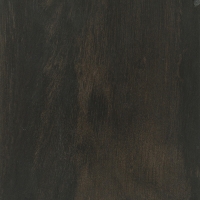 |
Common Name(s): Gaboon Ebony, African Ebony, Nigerian Ebony, Cameroon Ebony Scientific Name: Diospyros crassiflora Distribution: Equatorial West Africa Tree Size: 50-60 ft (15-18 m) tall, 2-3 ft (.6-1 m) trunk diameter Average Dried Weight: 60 lbs/ft3 (955 kg/m3) Specific Gravity (Basic, 12% MC): .82, .96 Janka Hardness: 3,080 lbf (13,700 N) Modulus of Rupture: 22,930 lbf/in2 (158.1 MPa) Elastic Modulus: 2,449,000 lbf/in2 (16.89 GPa) Crushing Strength: 11,060 lbf/in2 (76.3 MPa) Shrinkage: Radial: 8.3%, Tangential: 11.2%, Volumetric: 19.6%, T/R Ratio: 1.3 |
Color/Appearance: Heartwood is usually jet-black, with little to no variation or visible grain. Occasionally dark brown or grayish-brown streaks may be present.
Grain/Texture: Grain is usually straight but can also be interlocked. Fine even texture with very high natural luster.
Endgrain: Diffuse-porous; medium to large pores in no specific arrangement, few; solitary and radial multiples of 2-3; black mineral deposits present; growth rings indistinct; rays not visible without lens; parenchyma reticulate/banded, possibly marginal, apotracheal parenchyma diffuse-in-aggregates, paratracheal parenchyma vasicentric.
Rot Resistance: Ebony is rated as being very durable, with good resistance to termites and other insects.
Workability: Can be difficult to work due to its extremely high density. Has a dulling effect on cutters. Tearout may occur on pieces that have interlocked or irregular grain. Due to the high oil content found in this wood, it can occasionally cause problems with gluing. Finishes well, and polishes to a high luster. Responds well to steam bending.
Odor: Ebony has a mild, slightly unpleasant odor when being worked.
Allergies/Toxicity: Although severe reactions are quite uncommon, Ebony in the Diospyros genus has been reported as a sensitizer. Usually most common reactions simply include eye, skin, and respiratory irritation. See the articles Wood Allergies and Toxicity and Wood Dust Safety for more information.
Pricing/Availability: Gaboon Ebony is among the most expensive of all available lumbers: usually about two to three times more expensive than most species of Rosewood. The small size of the tree, and its high demand for ornamental work may contribute to its seemingly outlandish price.
Sustainability: This wood species is in CITES Appendix II (for Diospyros species from Madagascar), and is on the IUCN Red List. It is listed as endangered due to a population reduction of over 50% in the past three generations, caused by exploitation.
Common Uses: Small/ornamental items, such as piano keys, musical instrument parts, pool cues, carvings, and other small specialty items.
Comments: So named because historically most of the wood was exported from the nation of Gabon, though today it’s much more likely to be sourced from Cameroon.
There’s no mistaking Gaboon Ebony as there are few woods that are deep and solid black (unless dyed), and even most species in the Diospyros genus aren’t black. Other types of ebony include: Macassar (striped) Ebony, and Black and White Ebony. African Blackwood is very similar in density, color, and (unfortunately) cost, but is technically in the Dalbergia genus and isn’t considered a true ebony. Wenge and Katalox are two woods that are sometimes used as an ebony substitute.
The wood is exceptionally dense, strong, and stiff, though it is considered to have moderate to poor stability through seasonal changes.
Scans/Pictures: For the endgrain zoom, I’ve slightly modified the brightness of the image to help show the details of the pores and parenchyma. Due to its high density, you can also view a video showing how Ebony sinks in water.
A special thanks to Steve Earis for providing the turned photo of this wood species.
 |
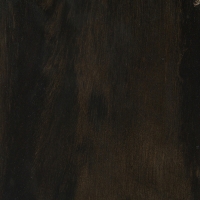 |
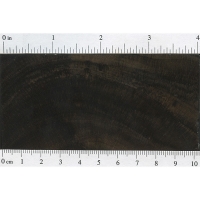 |
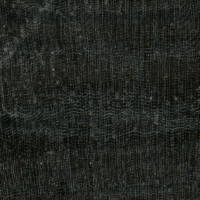 |
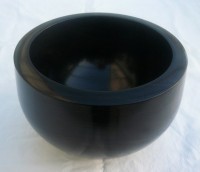 |
[iframe id=”https://www.youtube.com/embed/V-QJm6s7fHQ?rel=0″]





Hello Eric, I was wondering what kind of wood this is. It looks like Ebony. It took me some time to cut through it with a Japanese pull saw. The color is near black. It has a fairly straight grain structure and it sinks instantly in water. The wood has a high pitch when tapping the two pieces together and is relatively heavy in relation to its size.
Thank you for your time and this great database!
Bert
Birdmanknives
Are you familiar with the scent of ebony when being worked? Aside from this, you’d probably need to look at the end grain portion, though it’s too bad there doesn’t appear to be any sapwood, as it can be easier to see the anatomy in the sapwood portions — otherwise everything tends to just look black on black.
It would be awesome if you include pictures of the threes to your website.
Hi! Are the tiny lines in the 10x endgrain picture yearly growth rings?
No, they are not. The vertical lines are rays and the horizontal lines are parenchyma bands.
Hi Eric,
Any chance you would know if/when the Gaboon Ebony is exposed to the elements, sun, etc. if it will ‘fade’, lighten and otherwise turn gray over time (like most wood species exposed to the sun)?
Thanks
These were bought in Tanzania. They’re quite heavy and dense! Can they be the dalbergia melanoxylon or more of diospyros spp?
It doesn’t look dark enough to be blackwood or ebony. Possibly leadwood?
Might be blackwood. I have some similar Makonde carvings from Mozambique. Those carvers are usually very economical with the wood, so that they minimize the carving waste. The closer you get to the sapwood in the tree, the lighter the wood gets to where the actual sapwood is a cream color. if the various projections on the carvings are lighter than the areas deeper in the log, it’s probably blackwood.
Hi Eric
Any idea what type of wood is this?
Your pics didn’t attach, please retry or downsize them.
Here is the photo
It’s a very dark wood, but I’m really not able to do too much more towards ID without a closeup pic of the endgrain, preferably a part where the lighter colored sapwood is also present to make out the anatomical details better.
Not sure if these pics are clear enough. It looks rather dull black.
For woods like this, I would really be looking at the lighter colored sapwood to make out the anatomical details. Based on what I can see, I can’t make out any banded parenchyma, which would rule out ebony. This is of course assuming that your photos are in adequate enough detail to see the bands in the first place. There’s a chance that they could be there but the photo just isn’t sharp enough to show them. You would need to finely sand the endgrain and try to get an even closer pic of the lighter colored portion. Also keep… Read more »
Appears to be either African or Australian Blackwood (Dalbergia melanoxylon or Acacia melanoxylon) judging by the large ratio of heartwood per total area of the cross section. There are other Families that produce genus and species that also have a similar appearance to the specimen in the picture, but this much heartwood volume stands out.
Are you confusing Acacia melanoxylon with some other wood species? Despite its name, Australian blackwood isn’t really black.
I live in Australia and mill blackwood logs on a regular basis, and can say that that is definitely not Australian blackwood.
Hi Eric,
I have a large piece of wood that I think is Ebony. It’s roughly 30 x 36 and 1 inch thick. It came from a bandsaw kit that was built in the 50’s. Is there a way to confirm for sure if it’s truly Ebony?
Hi Eric,
Many violins’ fingerboards are made of ebony, but mine doesn’t look very typical. Could you tell from the photos what kind of wood it is? Does ebony have grains like that? It’s certainly some kind of hardwood because for over 20 years the strings haven’t left any mark on the fingerboard.
I agree it looks kind of weird. The grain doesn’t look like typical ebony to me. But the puzzling part is if it is performing like ebony. Has it been played much? Have you noticed any unusual wear?
This violin has been played very often in its first decade, and less often recently. No scratch on fingerboard. Every time after playing, my fingertips turned black and i thought it was because of the strings. When I first got the violin, the fingerboard was solid black and the grains weren’t so obvious, they slowly showed up over time and I noticed the brownish not long ago, that’s when I started to realize the fingerboard might be stained black. I can’t say if this is the original color yet. Just wondering what wood could it be. :)
Sounds pretty suspicious about fingertips turning black. It’s also strange that it appears there is either a knot or some sort of endgrain-type feature right in the middle of the fingerboard. You’d always want to use clear and defect lumber for this sort of application.
That’s true. So would you please let me know if you have any guess on what this wood might be? I’ll be appreciated.
No idea, sorry!
Still, thank you very much!
This is some other wood with black stain on it. Ebony does not have grain like that.
Please help. My husband found this 5.6 lb piece of (what I think is Ebony) wood on the ocean beach in Wa Sate.. It’s 12″ long x 6″wide x 2′ thick. it matches the Wood-database’s description of Gaboon Ebony. It took over an hour to drill press the holes in it for the air plants. I sprayed on a thin coat of lacquer to give it some sparkle. Second picture is the under side after he planed it smooth. Does anyone think this is Gaboon Ebony wood and how much is a hunk of wood like this worth in US… Read more »
If you’ve ever worked with ebony, you could compare the smell. Personally, I don’t think it’s very likely to be Gaboon ebony. There are a handful of woods that can be completely black, as well as others that may be discolored a black color due to some sort of mineral or staining, which may be the case if it washed up on the beach.
Ebony is so dense it does not float, so it’s unlikely that a piece ended up on a beach. However, its distinctive odor when milled could more positively identify it.
Hello…I have a walking stick with inlaid mother-of-Pearl that appears to be 2 different woods- half if more black and half more brown. Are you able to tell if the darker part is ebony?
Hi, I’m repairing a 19th century demi lune table and its banding (7mm x 2mm) in some places is very hard to tell what it is. its black and it breaks like plastic and it seems to have no grain(?)
Looking at the black piece, it appears to just be stained very dark and is naturally a much lighter color. The fracture line looks like wood. I can’t tell anything in regards to wood ID from that pic.
Hi Eric, thank you for your quick response. I have taken a better picture which might help to see more detail…(?)
Sorry, I can’t tell from the picture. The piece looks very small. You might try sanding it to see how the sawdust smells and acts. But that may be of limited value if you are not familiar with ebony.
I got some ebony that is more very dark brown and heavy. When I cut into it from any direction, the wood is bright yellow. After a month the yellow wood darkened somewhat. Is this some kind of dyed ebony? It was from a nice store.
I’ve never heard of such a thing happening with true Diospyros ebony, but it’s very common with katalox and other Swartzia species. It’s not dyed wood, just the nature of the wood itself.
Hello, I’m trying to find out if this little trinket pot is wood? It has clinking sound like clay! Thank you
It could possibly be ebony. Hard to tell conclusively from pics though.
Thank you very much for getting back to me. I’ve posted a close up of the lid, this might help to see the grain. I hope it’s clear enough. (The pot sinks by the way, when put in water). Thank you
It’s hard to say for sure, but I think I can see what appear to be pores, which would indicate that it’s a wood. And if it sinks in water, then it may very well be ebony. Another quirk of ebony is that it isn’t very dimensionally stable with changes in humidity, so I wonder if the lid sits perfectly flat on the base, or if there is a little bit of rocking or just a slightly less-than perfect fit?
I’m looking for the ebony used in Egypt by the Pharos. Where can I find that?
That is, I believe, African Blackwood, Dalbergia melanoxylon.
Any idea about this wood
Just remember that this is wood ia all but extinct.
I made a custom pool cue case out of this for a client. It took 3 months just to locate boards wide enough! As you can see for the attached picture it turned out awesome but I will never attempt it again. Too heavy to be practical and the box could break if dropped. But I have to admit it is the most beautiful case I have ever made!
The wood is brutal on your tools. The most interesting thing I discovered is the weird sawdust. Jet black is just strange to see!!
I have this wood on my Gibson Les Paul fingerboard and boy does it look (and sound) gorgeous!
I came across the word ‘ebony’ while reading the Bible book of Ezekiel in chapter 27 and verse 15. So I searched on line to see where it is grown. I have an all black rescue cat that I named Ebony. Not only is it fitting due to er color, but also because she is stubbornly quite vocal when she wants fed or just wants attention.
Jake is totally right about this expensive wood — Gaboon Ebony.
a better natual finish would be hard to find, just remember that the wood is murder on your hand tools, and you must go slow with the power saws. the smell from the dust can be nasty, it feels like you have swallowed soap.